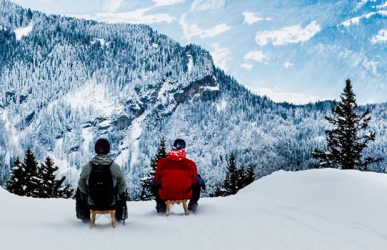How to build a Backyard Ice Rink?
It only happened once. A big patch of the side yard froze over with ice. It was 2-3 inches thick and big enough for a seven year-old to skate on. ‘Borrowing’ Mom’s ice skates and wearing several pairs of socks, I thought I was Dorothy Hamill as I glided across the ice. Spins, turns and even a few hops and I thought I was well on my way to the Olympics. My biggest challenges? Not skating off the edge of my rink into the grass and skating backwards. I never did learn how to skate backwards but boy did I have fun while my little backyard ice rink lasted.
My little rink was created by Mother Nature. But, you don’t have to wait for the perfect storm to have a backyard ice rink of your own. You’ll need consistent winter temperatures below freezing and a fairly flat section of yard. People in Canada and other outdoor ice hockey-loving climates have been building their own backyard rinks for generations. Today, you can have something as easy to install as a shallow inflatable pool to building a competition sized rink with side boards. Prices vary from several hundred dollars to thousands for the real die-hards who also install cooling elements in their ice. Today we’re going to keep it fairly simple and talk about some of the options that make building a rink easier for the typical back yard installation.
Backyard Ice Rink: The Basics
Most backyard ice rinks could best be described as a flooded and frozen above-ground pool. While much shallower than a swimming pool, the concept is essentially the same. You need a water-tight liner to hold water and a framework of some sort to keep the water pooled. The liner should be white; that way it won’t absorb heat and cause the ice to melt prematurely. A white liner will also help protect any covered grass and ensure it will be lush and green the following spring.
 If you opt to go big with your ice skating rink, double check your local zoning laws about pools and outdoor structures. Also, if making a larger skating surface, avoid building over septic or leach fields. The most important thing is to measure the slope of your yard. Don’t try to skip this step, otherwise you will likely have water overflowing the frame on the lower side/deep end or exposed liner at the shallow end.
If you opt to go big with your ice skating rink, double check your local zoning laws about pools and outdoor structures. Also, if making a larger skating surface, avoid building over septic or leach fields. The most important thing is to measure the slope of your yard. Don’t try to skip this step, otherwise you will likely have water overflowing the frame on the lower side/deep end or exposed liner at the shallow end.
If you plan on doing serious skating, be prepared to continuously maintain the ice surface and adding water pretty much on a daily basis. You won’t need a Zamboni by any means but it will require some time and the addition of new, thin ice layers on a regular basis. Also, any snow which falls on the ice should be removed as soon as possible to keep your ice surface smooth.
Understand What You Are Buying
When it comes to backyard ice rink kits make sure your read the packaging before you make your purchase. Some ‘kits’ only include the liner. Other kits will include the liner and a series of brackets to hold up your frame. Almost all of the kits, we have seen, require the homeowner to provide their own wood. Not providing the wood actually makes sense. Depending upon the slope of your yard, more or less wood will be required.
Even the most expensive and highest quality liners are typically made from plastic. That means they can get damaged and require repairs. Some of the kits include repair kits for sealing small holes and tears in the liner. Better liners typically last through several seasons, as long as care is taken to protect the liner during rink construction and use. One expert recommended not putting the liner in place until the weather forecast calls for a week of daytime temperatures that do not rise above freezing. He cautioned against putting the lining in early because furred and feathered backyard residents might decide it makes a great swimming hole and damage the lining.
Final Thoughts
A pair of final thoughts, be a good neighbor and consider where you will drain your melted ice when the spring thaws come. No matter how much fun they might have had on your rink, your neighbors won’t be happy if you destroy their flower beds or flood their basement. You might also want to check on your insurance policy before opening up your backyard ice rink to friends and neighbors.



